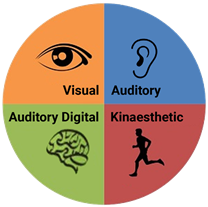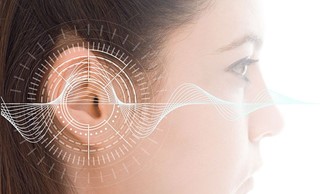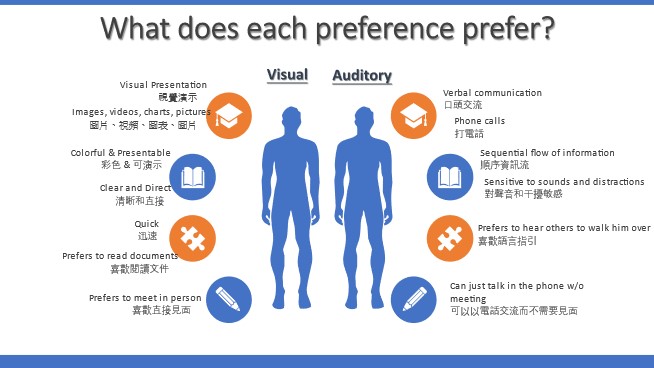I would like to share with you the following learning styles that form a model of learning to reveal the secrets and techniques around understanding your own learning mode and others preferred learning mode so as to communicate with everyone better.
What is Learning Style?
Scientists and psychologists have developed a few different models to understand the different ways that people learn best.
According to J. Reid (1995), learning style refers to an individual’s natural, habitual, and preferred ways of absorbing, processing, and retaining new information & skills.
Brown & Cooper (2000) considers learning style is consistent and enduring. Each student’s learning style might vary from one another, so finding out the unique learning styles of students to improve learning efficiency is one of the priorities of teacher.
One popular theory, the VAKAd models, identifies four primary types of learners, that illustrates below:
VAKAd Learning Style
This model identifies four different types of Learners:
Visual, Auditory, Kinesthetic, and Auditory Digital

Each learning style responds best to a different method of teaching. For instance, auditory learners will remember information best after reciting it back to the presenter, while Kinesthetic learners will jump at the chance to participate in a hands-on activity.
The VAKAd learning model divides people into four categories of learner:
Visual learners
Absorb information by sight

Visual stimulations produce best learning efficiency:
- Prefer to read or to use graphics to assist learning
- Would like teacher to write main points on board
- If teacher use verbal discussion, visual style learner might find it difficult to catch the points
- Enjoy art, aesthetics and the written word
Are imaginative and can easily picture complex scenarios, images or ideas
Auditory Learners
Absorb information primarily by hearing it

Auditory type people prefer to use auditory senses to learn:
- Prefer discussion and verbal explanation
- Understand and process information by talking it through
- Sensitive to tone of voice, pitch and rhythm
- Listen to radio, audio program, tapes or CD
- Learn better with music on, provided that it is not distracting
- Are good at oral presentation
Kinesthetic learners
Absorb information primarily through experience-oriented learning

Experience-oriented learning or through movement in a physical way:
- Active in different activities like extra-curricular activities
- Enjoy cosplay during class or Total Physical Response (T.P.R.)
- Might feel impatient about sitting too long for lecture
- Are good at hands-on problem solving
- Have a good sense of direction
Auditory Digital (Ad) learners
Absorb information with information and data

Usually transcends one’s senses, vision, or hearing to analyze oneself and things:
- Reminds people of artificial intelligence
- Memorize by creating or learning steps, systems and procedures
- Prefer working with information and data
- Logic driven
- People who read a lot tend to be auditory digital learner
You can do the Quick Assessment Preference Test (as below) and find out your preferred learning style:
When you know about your learning style, it is easy to find a way/channel to learn best. However, if you have a chance to know others’ learning style, it will create a better communication with others in the best possible way.
Thus, how to find out the preference of others and how can you communicate with others in the best possible way that leads to win-win outcomes?
Observe Other’s Physiology:
Visual learners
- Stand or sit with their heads and/or bodies erect, with their eyes up
- Sit forward in their chair
- Organized, neat, well-groomed and orderly
- Often thin and slender
- Memories by seeing pictures, and are less distracted by noise
- Have trouble remembering verbal instructions because their minds tend to wander
- Interested in how your idea LOOKS. Appearances are important to them
Auditory Learners
- Often move their eyes sideward
- Interested in what you have to say about your idea
- Typically talk to themselves (some even move their lips when they talk to themselves
- Can be easily distracted by noise
- Repeat things back to you easily
- Learn by listening, usually like music and talking on the phone
- Memorize by steps, procedures, and sequences (sequentially)
- Likes to be TOLD how they are doing, and responds to a certain tone of voice or set of words

Kinesthetic learners
- Often move and talk very slowly
- Respond to physical rewards, and touching
- Stand closer to people than a visual person
- Memorize by doing or walking through something
- Interested in your program if it “feels right”, or if you can give them something, they can grasp
Auditory Digital (Ad) learners
- This person will spend a fair amount of time talking to themselves
- They will want to know if your program “make senses”
- They can exhibit characteristics of other major rep. system




